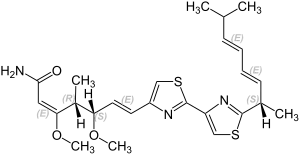Myxothiazol
Myxothiazol (produced by the myxobacterium Myxococcus fulvus) is an inhibitor of the mitochondrial cytochrome bc1 complex (coenzyme Q - cytochrome c reductase).
 | |
| Names | |
|---|---|
| IUPAC name
7-{2'-[(1S,2E,4E)-1,6-dimethyl-2,4-heptadienyl] | |
| Identifiers | |
3D model (JSmol) |
|
| ChEBI | |
| ChemSpider | |
| ECHA InfoCard | 100.151.224 |
| MeSH | Myxothiazol |
PubChem CID |
|
| UNII | |
| |
| |
| Properties | |
| C25H33N3O3S2 | |
| Molar mass | 487.68 g/mol |
Except where otherwise noted, data are given for materials in their standard state (at 25 °C [77 °F], 100 kPa). | |
| Infobox references | |
Myxothiazol is a competitive inhibitor of ubiquinol, and binds at the quinol oxidation (Qo) site of the bc1 complex, blocking electron transfer to the Rieske iron-sulfur protein. Binding of myxothiazol induces a red-shift to the visible absorption spectrum of reduced haem bl. In contrast to stigmatellin, myxothiazol does not form a hydrogen bond to the Rieske iron-sulfur protein, binding instead in the 'b-proximal' region of the cytochrome b Qo site. Movement of the cytoplasmic domain of the Rieske protein is therefore unaffected by the binding of this inhibitor.
This article is issued from Wikipedia. The text is licensed under Creative Commons - Attribution - Sharealike. Additional terms may apply for the media files.